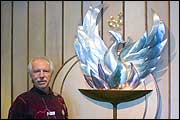Sculpture marks congregation's renewal
How an Atlanta congregation rebuilt itself.
The sculpture, about five feet high and four feet wide, was done by congregant Antonio Borra (pictured) and is made of shaped and polished aluminum, copper, brass, and carved cedar set against a birch background. Borra said that the darker copper flames in the chalice represent the old congregation and the brass flame in the center represents the newer one. “Congregants can see themselves reflected in the brass flame and in the phoenix,” Borra said.
Dedicated in November 2004, the year the congregation celebrated its fiftieth anniversary, the sculpture also honors the Rev. Dr. Edward Frost, who was retiring after sixteen years at the church.
The church’s adopted symbol, a phoenix, is also Atlanta’s icon, representing the city’s rebirth after being destroyed in the Civil War.








